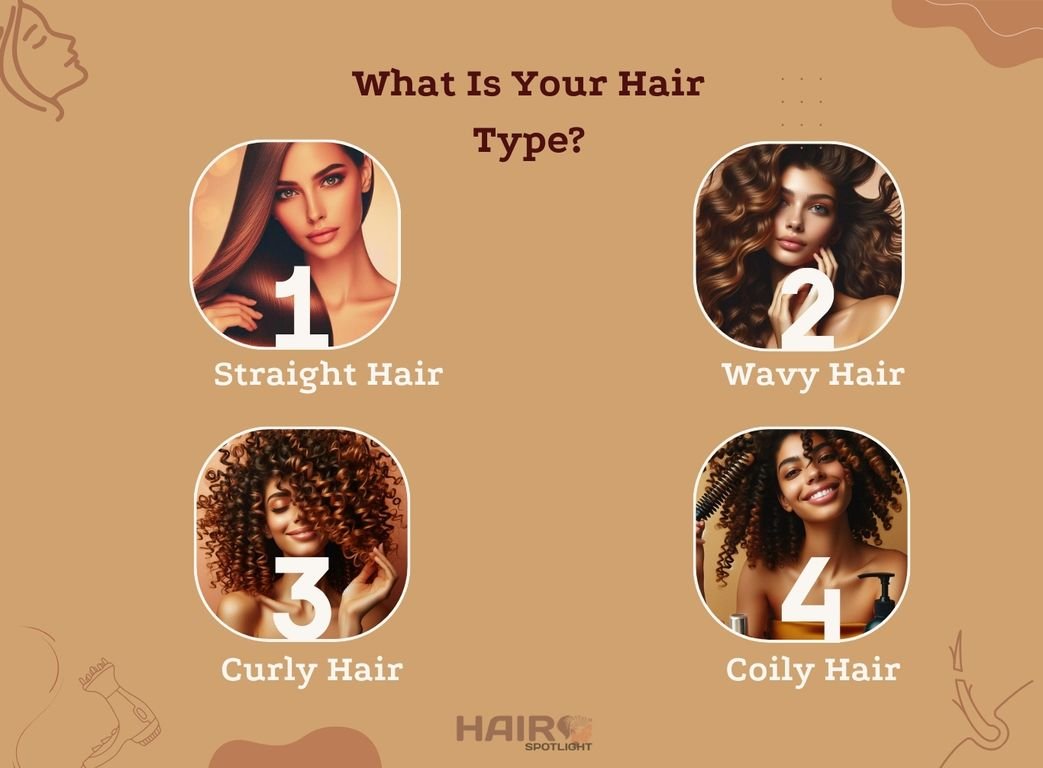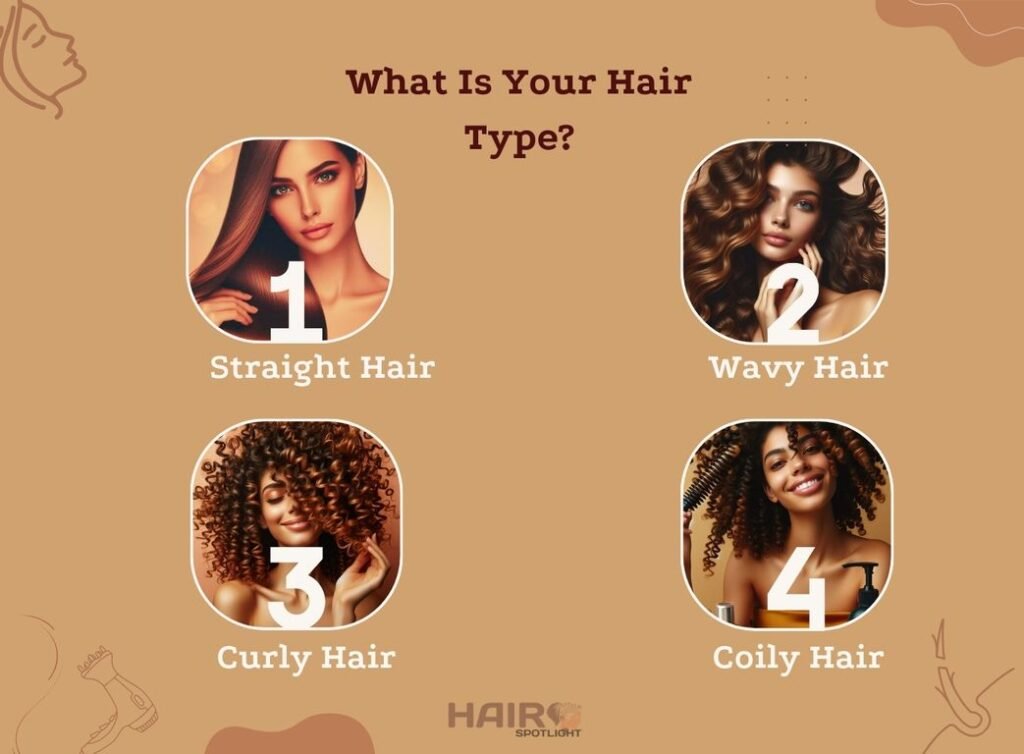
Introduction:
Have you ever stared in the mirror, frustrated by your hair’s unpredictable waves or stubborn frizz? You’re not alone! Millions struggle to understand their unique hair type and texture, leading to endless styling battles and disappointing results.
But what if I told you the secret to unlocking your hair’s full potential lies not in expensive products but in understanding its very essence? Your hair type and texture are like its hidden language—a code that reveals its specific needs and how to care for it.
I spent years wrestling with my hair. One day, it would hold a curl; the next, it would be a flat, limp mess. Countless products promised “perfect waves” or “silky smoothness,” but nothing seemed to work consistently. Finally, I discovered the secret weapon: understanding my hair type and texture.
Did you know that hair experts categorize hair into four types (straight, wavy, curly, and coily) with further subcategories based on texture (fine, medium, and coarse)? This seemingly simple classification unlocks a world of possibilities for styling and care.
Imagine finally knowing which products will work for your hair, effortlessly achieving the styles you’ve always craved, and embracing your hair’s natural beauty. This guide will be your roadmap to achieving exactly that.
Continue reading to embark on a hair discovery journey, where you’ll learn to decode your hair’s unique language and unlock its full potential!
What are the types and textures of hair?
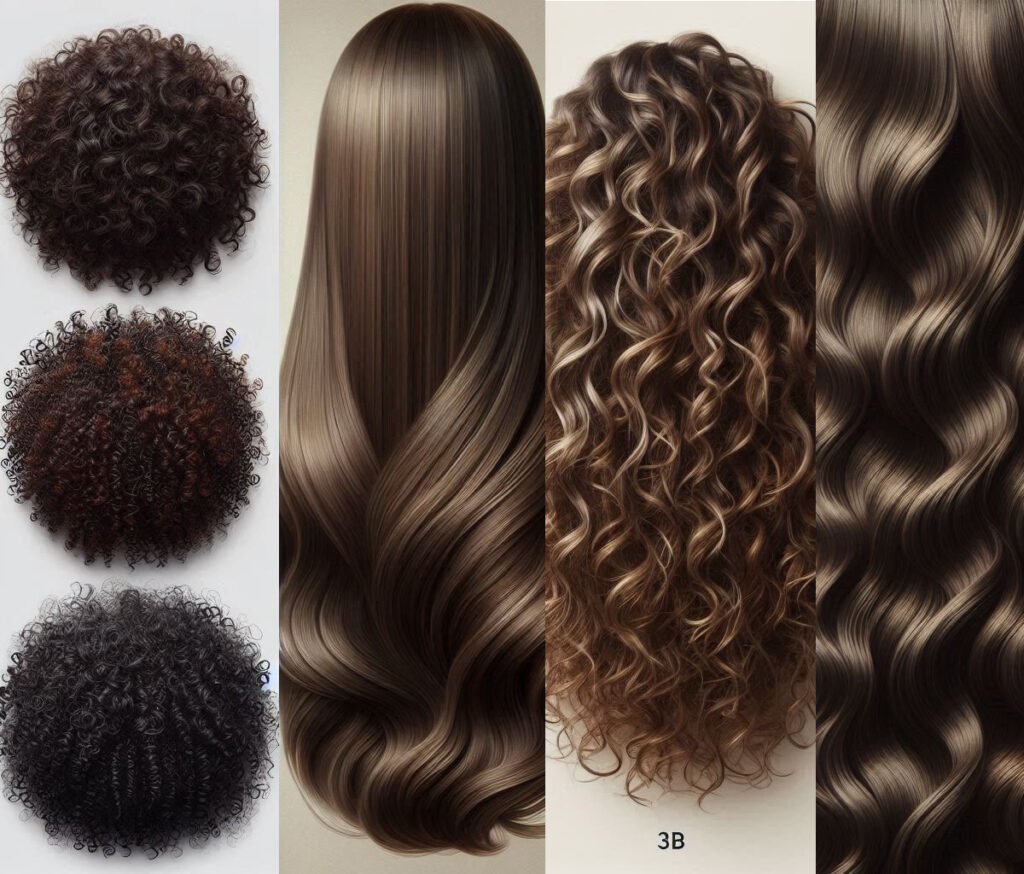
Hair has two key characteristics that influence its appearance and manageability: hair type and hair texture.
The combination of your hair type and texture creates your unique hair profile. Understanding these characteristics is crucial for developing a hair care routine that keeps your hair healthy and looking its best.
Hair Types:
refers to the overall curl pattern of your hair in its natural state. There are four main hair types: straight, wavy, curly, and coily. These categories describe how your hair strands naturally curve or bend. Each main hair type (1-4) can be further categorized into subtypes (A, B, and C) based on the hair’s texture and curl definition. This creates a more detailed classification system with 12 hair types.
Here’s a chart summarizing the main hair types and their key characteristics:
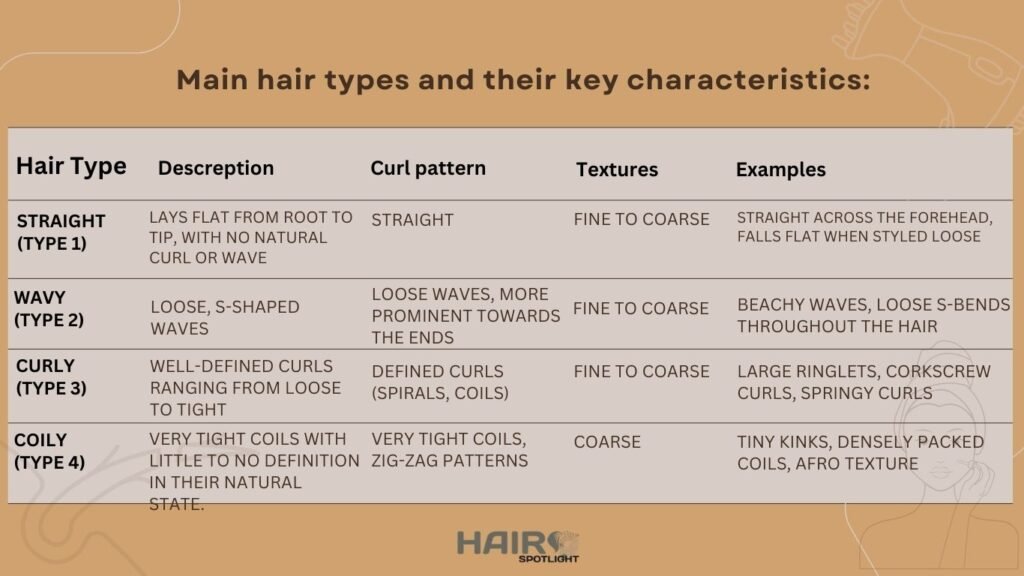
Hair Textures:
describes the thickness of individual hair strands. Hair texture can be fine, medium, or coarse. It’s independent of the curl pattern, so you can have fine straight hair, coarse curly hair, or any combination in between.
Here’s a table summarizing the two concepts:

This guide will be your roadmap to haircare bliss. We’ll unveil the four main hair types and their 12 sub-textures, helping you identify yours and discover a world of styling and care options designed specifically for your unique strands.
Type 1 hair, straight hair:

Type 1 hair is the straightest type, with no bends or curves. It generally has the most sheen of all hair types and tends to be the most resilient and resistant to damage. However, this straightness also makes it the most susceptible to oiliness, as sebum from the scalp travels easily down the hair shaft. Type 1 hair can be fine or thick, but it tends to be shiny and smooth.
Here’s a breakdown of the sub-textures for straight hair:
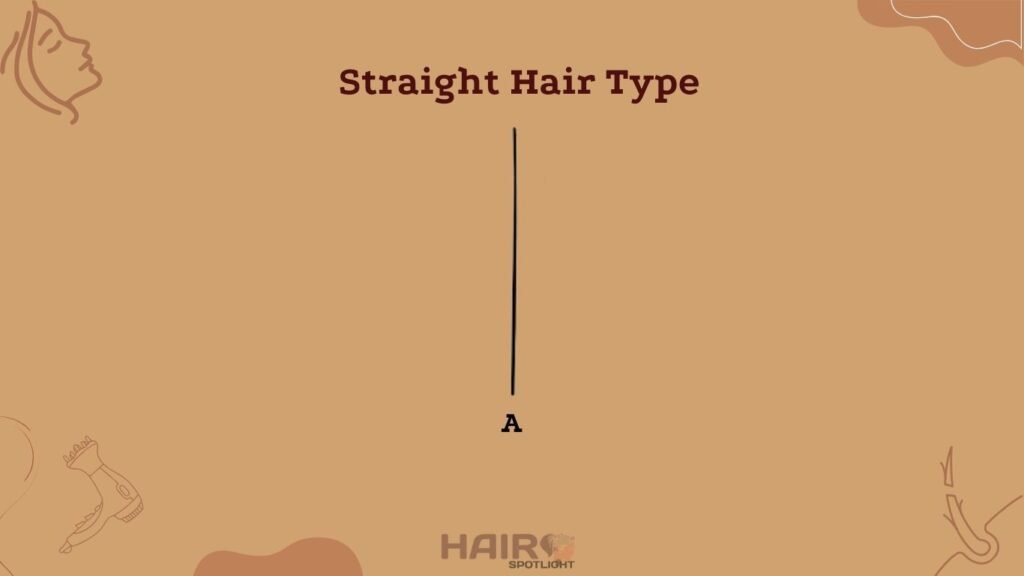
1A Hair: Fine Straight Hair
1A hair is the finest and straightest hair type of all. Even when wet, it falls completely flat and uniform from roots to ends, lacking any bends or waves. This hair type has a beautiful shine but lacks texture, making it difficult to style.
1B Hair: Straight Hair with Body
1B hair falls between the super-straight 1A type and the slightly wavy 1C type. It’s called straight hair with a twist.
Here’s a quick comparison of 1A and 1B hair:
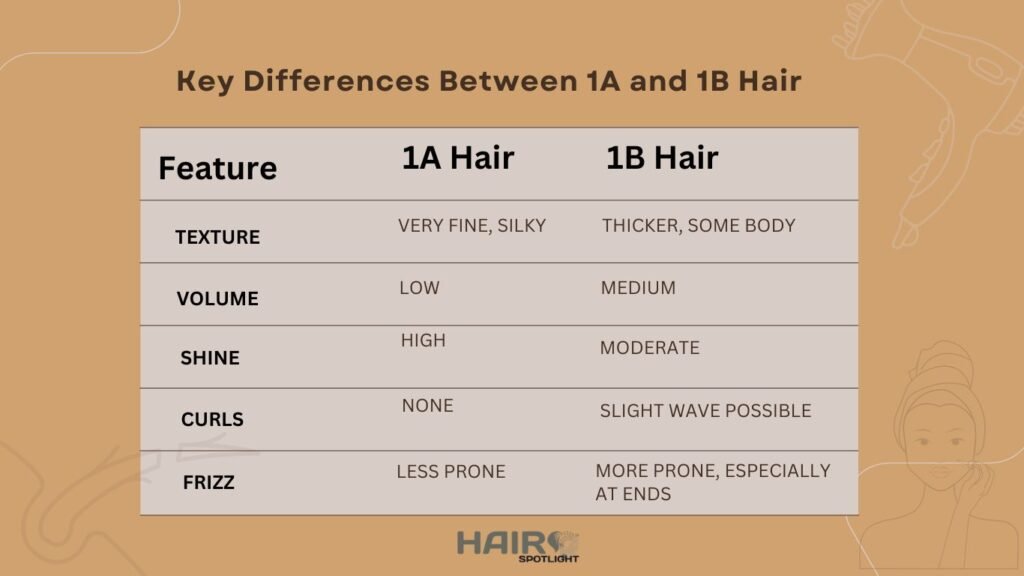
1C Hair: Coarse Straight Hair
1C hair is the waviest of the straight hair types, teetering on the edge of being classified as truly wavy.
Here’s a table summarizing the key differences between 1A, 1B, and 1C hair:
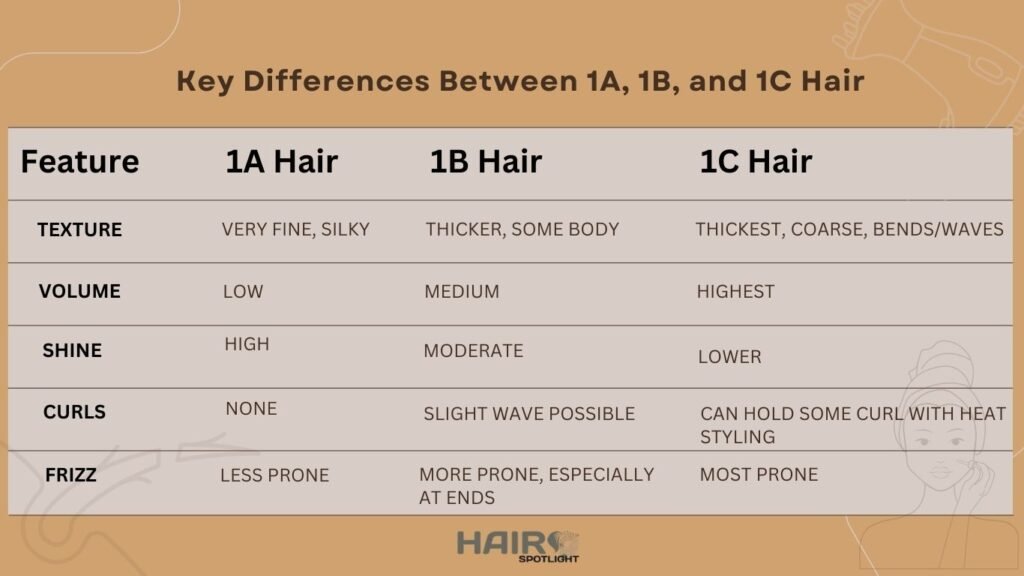
hair type 2 : wavy hair
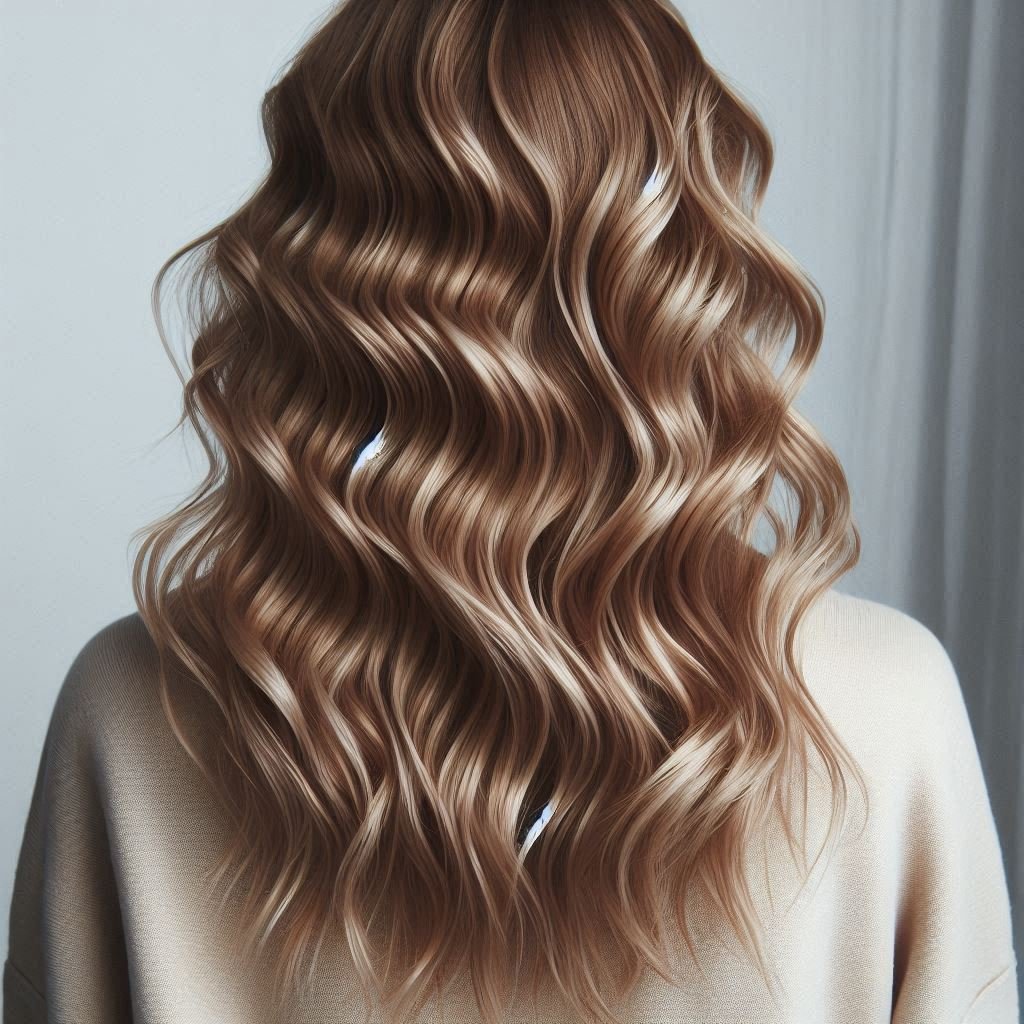
Wavy hair (Type 2) exists in a beautiful spectrum between straight and curly hair. It boasts loose, S-shaped waves that can vary in terms of tightness and definition.
Here’s a look at the sub-textures of wavy hair:
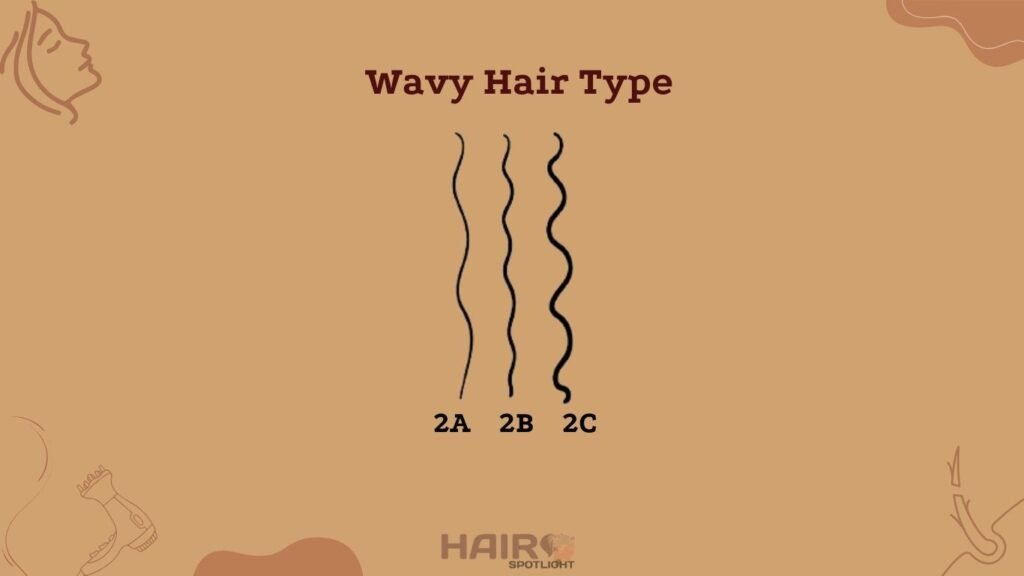
2A Wavy Hair: Wave with a Hint: The Elusive “S-Wave Whisperer”
2A hair is the loosest wavy hair type, often appearing almost straight with a slight wave or curl definition throughout the length. It falls under the wavy hair category and is characterized by its fine texture and gentle, tousled texture, which can sometimes look beachy.
2B Wavy Hair: Defined S-Waves: Defined Beachy Waves You’ll Love
With its beautiful, defined S-shaped waves, 2B hair occupies the sweet spot between straight and curly, offering the best of both worlds.
Here’s a quick comparison of the 2A and 2B hairs:

2C Hair type : is almost curly.
2C hair sits at the cusp between wavy and curly, often described as “wavy with attitude.” It boasts beautiful, well-defined S-shaped waves that are more prominent than their 2A and 2B counterparts.
Here’s an example of how 2C hair compares to its wavy cousins:
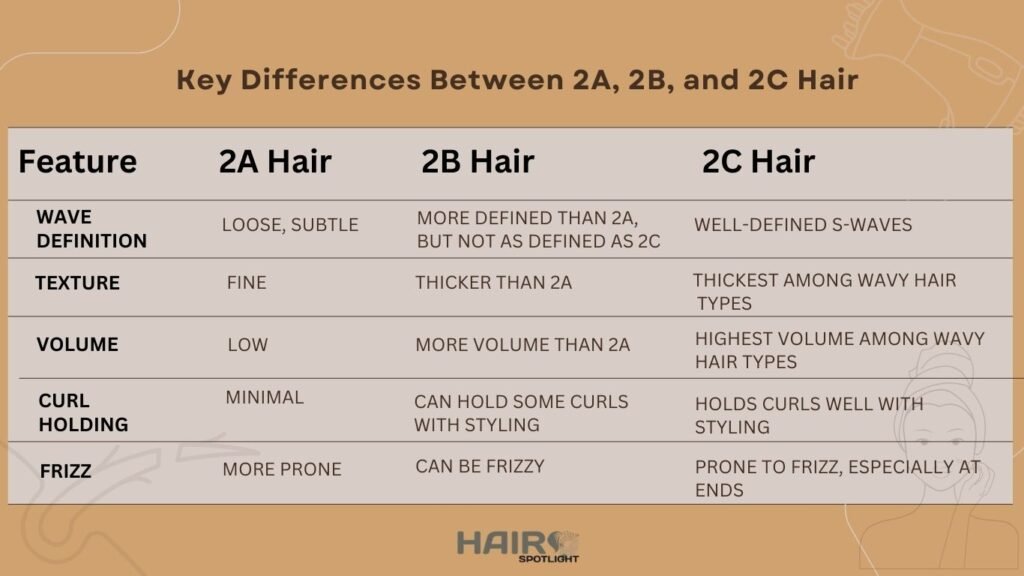
Type 3 hair: curly hair

Curly hair (Type 3) is a land of beautiful spirals, coils, and ringlets with a wide range of textures. This hair type has well-defined curls that range from loose spirals to tight coils.
Here’s a breakdown of the curly hair sub-textures:
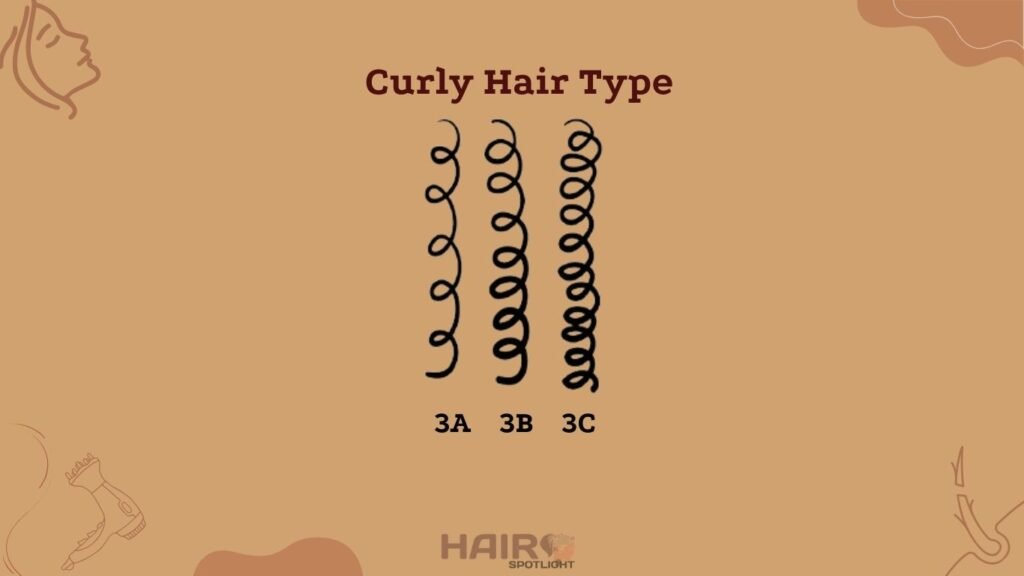
3A Hair: Large, Loose Curls
3A hair is the curliest hair type within the curly hair category (type 3). It’s known for its large, loose curls that resemble the shape of a spring or a wide S-bend.
3B Hair type : Medium-Tight Coils
3B hair falls right in the middle of the curly hair spectrum (type 3). It is known for its bouncy, defined curls, which are tighter than 3A curls but not quite as corkscrew-like as 3C curls.
Here’s a table summarizing the key differences between 3A and 3B hair types:
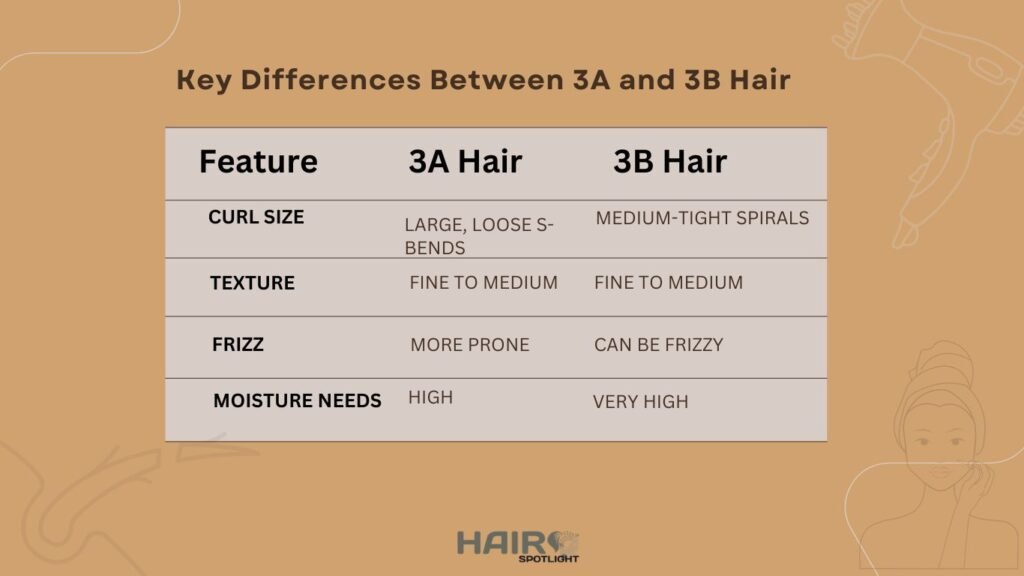
3C Hair: Tight Corkscrew Curls
3C hair is the curliest type within the curly hair category (type 3), known for its tight coils that form spring-like or zig-zag shapes.
Here’s a comparison of 3C hair with its curly cousins:
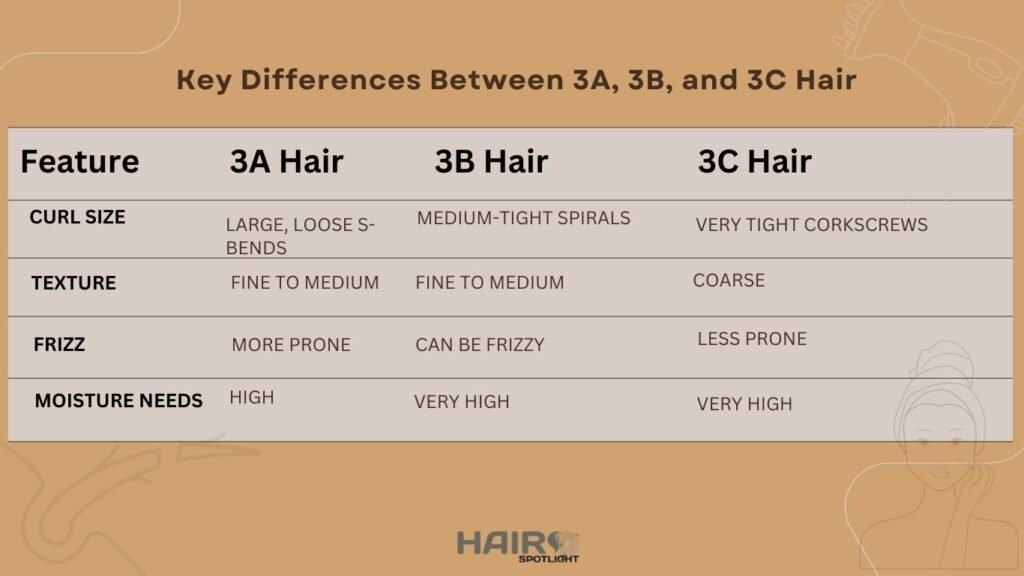
Type 4 hair: Coily hair
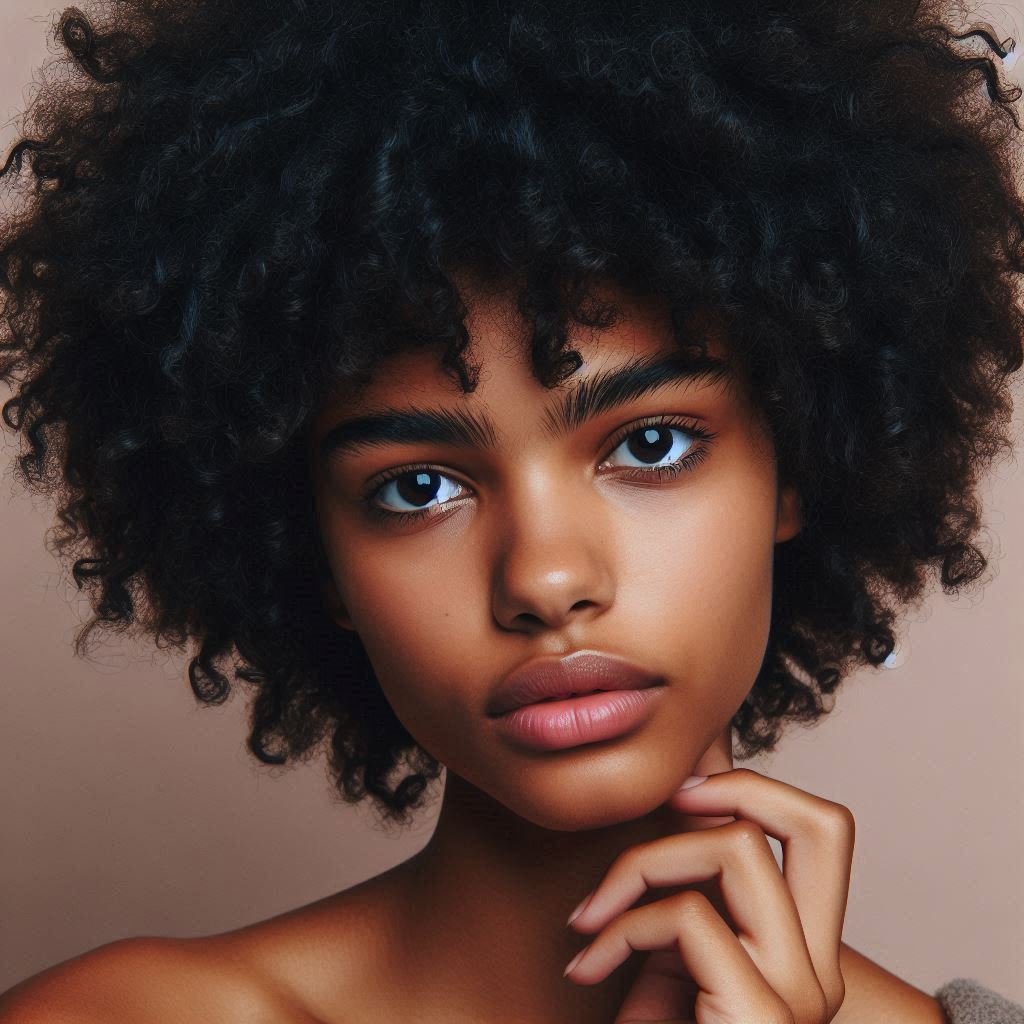
Coily hair (Type 4) is known for its beautiful and densely packed coils, but within this category, there are variations in texture that affect manageability and styling.
Here’s a look at the sub-textures of coily hair:
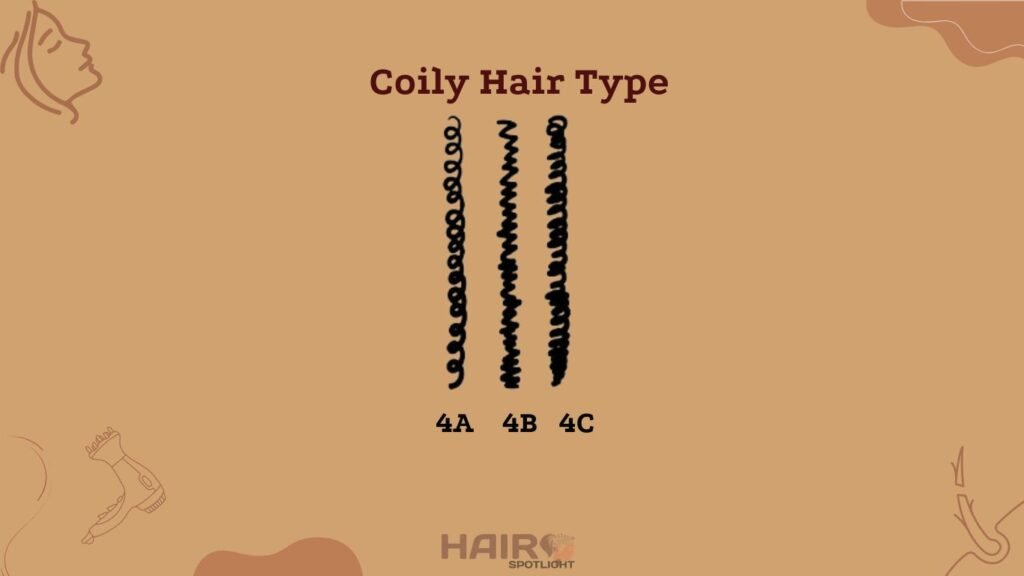
4A Hair: Tightly Coiled Springs
4A hair is the curliest type within the “coily” hair category (type 4). It’s known for its tightly coiled strands that resemble tiny springs or crochet needles.
4B Hair: Tiny Wiry Coils
4B hair is a coily hair type (type 4), known for its densely packed, tightly wound coils that form a more irregular pattern compared to 4A hair.
Here’s a table summarizing the key differences between 4A and 4B hair types:

4C Hair: Extremely Tight Zigs-Zags
Hair type 4c is the coiliest hair type, belonging to category 4 on the hair typing system. It’s known for its very tight, springy coils that grow in a dense, zig-zag pattern with little to no definition.
Here’s a comparison of 4C hair with its coily cousins:
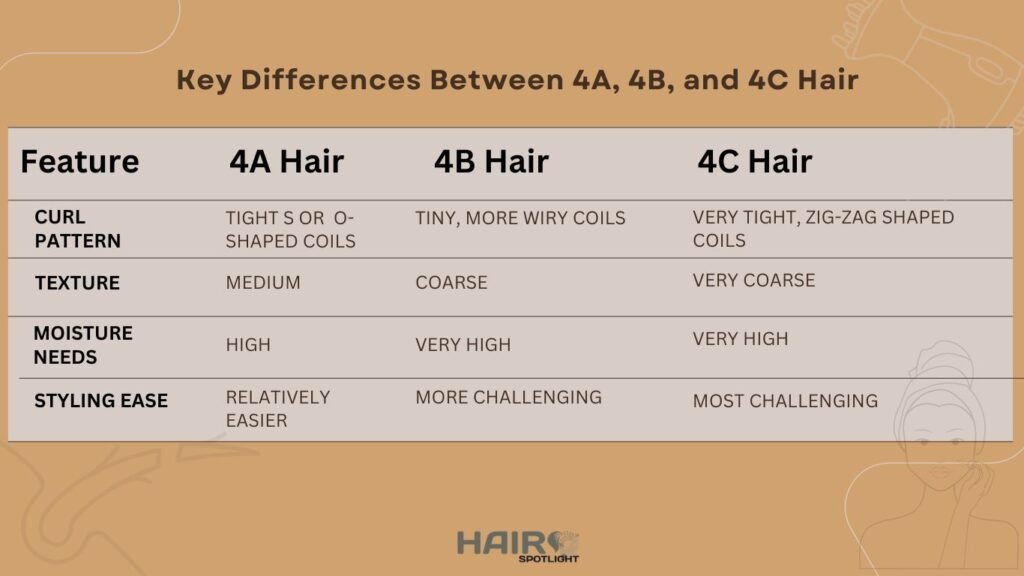
What is my hair type?
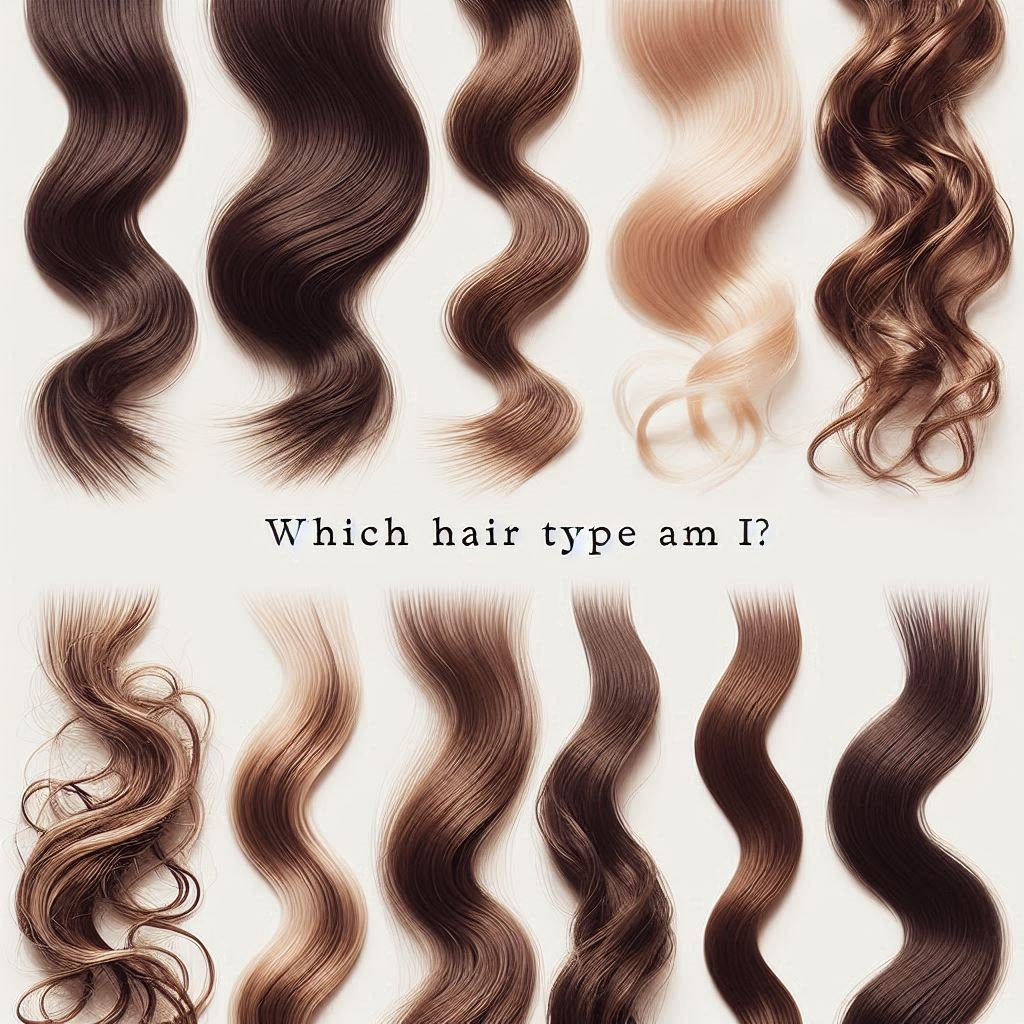
I can’t definitively tell you what your hair type is without seeing it in person. However, I can help you narrow it down based on the characteristics you’ve described.
Here are some resources that might be helpful in further identifying your hair type:
- Online quizzes: Many hair care brands and websites offer quizzes that can help you determine your hair type based on a series of questions.
- Visual guides: Look for online resources with pictures illustrating the different hair types and textures.
- Consult with a hairstylist. A professional hairstylist can examine your hair and give you a definitive answer about your hair type.
Using these factors and the resources provided, you should be able to determine your hair type!
How can hair types and textures contribute to your haircare routine?

Understanding your hair type and texture is the foundation of effective hair care! Here’s how knowing your hair type and texture benefits your hair care routine:
Choosing the Right Products:
- Tailored Approach: Hair types and textures have different needs. For example, curly hair needs more moisture than straight hair. Knowing your type helps you choose products formulated for your specific needs, whether it’s for hydration, frizz control, or volume enhancement.
- Avoiding Unnecessary Products: Some products can weigh down certain hair types. For example, heavy styling creams might be too much for fine hair (2A or 1A), whereas coarse hair (like 4C) might benefit from them. Understanding your texture helps you avoid products that could leave your hair feeling greasy or limp.
Effective styling techniques:
- Maximizing Results: Knowing your hair type allows you to choose styling techniques that work best for you. For example, diffusing is a wonderful way to dry curly hair (3A-3C) and coily hair (4A-4C) while minimizing frizz. Straight hair (Type 1) might benefit from heat styling tools for curls or straightening.
- Avoiding Damage: Using the wrong styling techniques can harm your hair. For example, frequently straightening curly hair can lead to dryness and breakage. Knowing your texture helps you choose techniques that enhance your natural hair while minimizing damage.
Overall Hair Health:
- Healthy Habits: Understanding your hair type allows you to develop a personalized hair care routine that promotes healthy hair growth and prevents problems like dryness, breakage, or split ends. For example, someone with coily hair (4A-4C) might need to deep condition more often than someone with straight hair (Type 1).
- Confidence Boost: Taking care of your hair the right way can make it look and feel its best. When you understand your hair type and texture, you can embrace its unique qualities and style it with confidence!
Understanding your hair type and texture opens up a world of hair care possibilities, allowing you to achieve healthy, beautiful hair that looks and feels its best!
Conclusion:
Throughout this post, we’ve explored the diverse world of hair types and textures. From the sleek strands of Type 1 straight hair to the springy coils of Type 4, each variation offers unique characteristics and requires specific care. Understanding your hair type empowers you to create a personalized hair care routine that enhances your natural beauty.
But remember, this knowledge is just the beginning! Embrace your hair’s individuality and experiment with products and techniques designed to nurture its health. There’s no single “right” way to care for your hair; the key is to find what works best for you.
Frequently Asked Questions
What are the 4 types of hair?
Hair is generally classified into four main types based on its natural curl pattern:
- 1. Wavy Hair (Type 2): This hair type has no natural curl or wave and lays flat from root to tip.
- Wavy Hair (Type 2): This hair type has loose, S-shaped waves that can be more prominent towards the ends.
- Curly Hair (Type 3): This hair type has well-defined curls that range from loose spirals to tight coils.
- Coily Hair (Type 4): This hair type has very tight coils that grow in a dense zig-zag pattern with little to no definition in its natural state.
What are the 12 different hair types?
Each main hair type (1-4) can be further categorized into subtypes (A, B, and C) based on the hair’s texture and curl definition. This creates a more detailed classification system with 12 hair types.
(A1, A2, A3)
(B1, B2, B3)
(C1, C2, C3)
(D1, D2, D3)
How do I identify my hair type?
The easiest way to identify your hair type is to observe its natural curl pattern and texture when it’s clean and dry and hasn’t been styled with heat or products. Look for characteristics like:
- Presence and definition of waves or curls
- Hair thickness and coarseness
- Overall volume
Consulting a hairstylist familiar with hair-typing systems can also help you determine your hair type.
What type of hair is good?
All hair types are good! Each type has its own unique beauty and characteristics. What matters most is learning how to care for your specific hair type to keep it healthy and manageable.
What is 1B hair?
1B hair is a subtype of straight hair that falls between super-straight 1A hair and wavy 1C hair. It’s essentially straight hair with a little bit of extra body and volume. It may have a slight wave or bend, particularly towards the ends.
Is the 2B hair type good?
Absolutely! 2B hair is a type of wavy hair with defined S-shaped waves. It’s a versatile hair type that can be styled to look wavy, straight, or even with some looser curls.
What is 3C hair?
3C hair is a curly hair type known for its tight coils that form spring-like or zig-zag shapes. It has a coarse texture and is less frizz-prone than looser curl patterns because the tight coils help to trap moisture.
Do I have 4C or 4B hair?
Here’s a quick comparison to help you distinguish between 4B and 4C hair:
- 4B Hair: Tiny, wiry coils with a more irregular zig-zag or bent corkscrew pattern. Coarse texture.
- 4C Hair: Very tight, extremely wiry coils with little to no definition in their natural state. Very coarse texture.
If you’re unsure, consult with a hairstylist familiar with hair typing systems for a more definitive answer.
What is a wavy hair type?
Wavy hair (Type 2) has S-shaped waves that range from subtle to defined. It’s thicker than straight hair but finer than curly hair, and it can be prone to frizz. Think beachy waves!
What is curly hair?
Curly hair (Type 3) is all about those beautiful, springy curls! These coils range from loose spirals (3A) to tight corkscrews (3C). It tends to be drier than straight or wavy hair and has a coarser texture, so keeping it hydrated is key!
What is a coily hair type?
Coily hair (Type 4) is all about the tightest coils! Imagine tiny kinks or loops that clump together densely (4A). Unlike curly hair, coily hair often lacks a well-defined curl pattern when left in its natural state. It has the coarsest texture of all hair types and needs a lot of moisture to prevent dryness and breakage.
What is straight hair?
Straight hair (Type 1) is the simplest to define: it has minimal to no natural bend and lays flat from root to tip. It can range from fine and silky (1A) to coarse and thick (1C). While versatile for styling, straight hair can sometimes lack volume.


